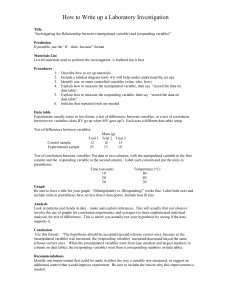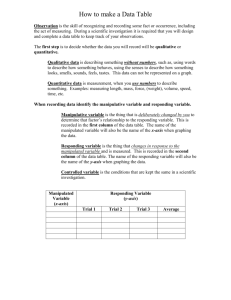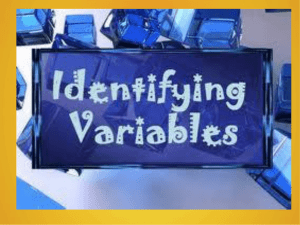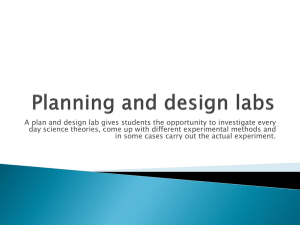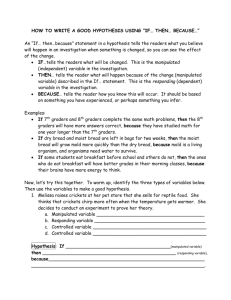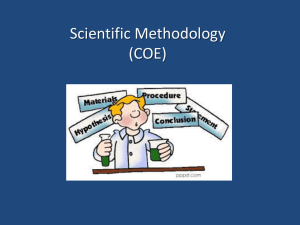SMED (Skills Book)
advertisement
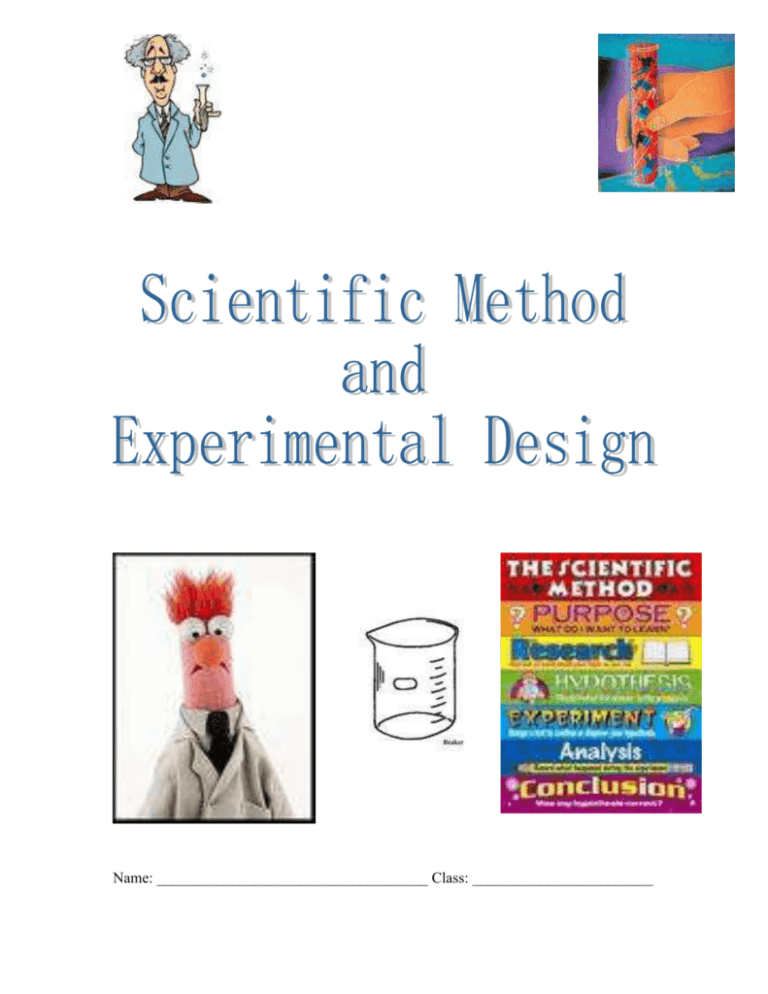
Name: ____________________________________ Class: ________________________ All human beings share a desire to explore and understand the world around us. Science developed out of this curiosity. Science is based on empiricism – a search for knowledge based on experimentation and observation. Sometimes observations are made directly with the human senses. Sometimes technological devices, such as microscopes, are used to help. Scientists believe that without meaningful observations based on thoughtful use of experience, the evidence or data needed to understand a problem will be incomplete. There are two basic types of observations –qualitative and quantitative. Qualitative observations describe and quantitative observations measure. Scientists usually try to use quantitative observations because they are more precise. Thoughtful observations communicate. They are clear and detailed and take practice. When constructing your observations, be sure that all readers understand and agree with your statements. Therefore, do not use opinions (ex. that tastes bad), comparative words without something to compare that observation to (ex. that is big), colors, or make statements about what you think the observation means (ex that bug flies – while you observe a dead bug). Observing can take place with ANY of your five senses. For our next activity, we are only going to use our sense of sight. Your task is to make three different types of observations about a penny. First, you will make observations about a penny from memory. Next, you will observe a penny for one minute and THEN record your observations, without looking. Finally, you will make continuous, direct observations. Step 1: From memory, draw the front and back of a penny in the circles. Do NOT look at a penny. Record some of your observations on the lines below. FRONT BACK ________________________________________________________________________ ________________________________________________________________________ 2 Step 2: Observe a penny for one minute and then place it out of sight. Draw the front and back of the penny in the circles. Compare your drawings to those you drew in Step 1. Record any similarities and differences on the lines below. FRONT BACK ________________________________________________________________________ ________________________________________________________________________ Step 3: Observe a penny for as long as you need. Use a hand lens if you wish. Draw the front and back of the penny in the circles. Tell how your drawings changed over the three steps. FRONT BACK ________________________________________________________________________ ________________________________________________________________________ When you observed the penny, you were probably making qualitative observations that described observable characteristics. The penny was brown. The person on the front had curly hair. However, in order to think like a scientist, it is necessary to make some quantitative observations – observations that require measurement or numerical calculation. An example would be that the Lincoln Memorial on a penny has twelve columns. Make as many quantitative observations for a penny as you can. Record your observations, what KIND of observation you could make, or what kind of tools you could use to make these kinds of observations on the lines below. ________________________________________________________________________ _______________________________________________________________________ ________________________________________________________________________ ________________________________________________________________________ ________________________________________________________________________ ________________________________________________________________________ 3 The world is a lot more enjoyable when the things that happen around us are understandable. When we observe patterns that are similar or events that remind us of experiences we’ve had previously, a new experience can be appreciated more fully. The explanations we use to depict events we experience are often called inferences. Inferences are based on observations and are simply explanations of observations. One can infer what they believe has already happened, why it happened, or what will happen next. The ability to infer helps us make sense of our environment. The only rule of inferring is to be logical. Inferences are always tentative. They are not final explanations of an observation. Sometimes there are several logical inferences for a given observation and you cannot be sure which inference best explains the observation. In such instances, you will need additional information. Inferences are often changed when new observations are made. Read the following observations. Then make inferences that explain each observation. Remember, there may be more than one logical explanation. Observation 1: You observe that the sky at noon is darkening. Your inference: __________________________________________________________ Observation 2: The principal interrupts class and calls a student from the room. Your inference: __________________________________________________________ Observation 3: A siren is heard going past the school. Your inference: __________________________________________________________ Observation 4: The classroom lights are off. Your inference: __________________________________________________________ 4 Use the pictures that follow to make observations (qualitative and quantitative) and inferences. Qualitative Observation: _____________________________________ __________________________________________________________ Quantitative Observation: ____________________________________ __________________________________________________________ Inference: _________________________________________________ __________________________________________________________ Qualitative Observation: _____________________ _________________________________________ Quantitative Observation: ____________________ _________________________________________ Inference: _________________________________ _________________________________________ Qualitative Observation: _________________________ ______________________________________________ Quantitative Observation: ________________________ ______________________________________________ Inference: _____________________________________ ______________________________________________ 5 By studying simple actions and reactions, you can learn that observing and inferring are the basis of science. But actions and reactions in the natural world are often complex. Sometimes they are so large (like the explosion of a volcano), or so small (like the movement of a Euglena), or so distant (like the birth of a star), or so spread over time (like the movement of a glacier) that it is impossible for the human mind to understand them in their entirety. The scientific approach to understanding such events is a process that breaks complex events into parts that can be studied and understood. These parts of an event or system are called variables. Variables are factors, conditions, and/or relationships that can change or be changed in an event or system. They are all the tiny little parts that could change the outcome of what you are observing. Identify possible variables in the following situations. What variables can affect the number of fish in a lake? ________________________________________________________________________ ________________________________________________________________________ ________________________________________________________________________ What variables can affect the taste of a soft drink? ________________________________________________________________________ ________________________________________________________________________ ________________________________________________________________________ What variables can affect the amount of fruit produced by an apple tree? ________________________________________________________________________ ________________________________________________________________________ ________________________________________________________________________ What variables can affect the speed of a runner in a 100-yard dash? ________________________________________________________________________ ________________________________________________________________________ ________________________________________________________________________ 6 In a Scientific investigation there are three kinds of variables. A manipulated variable, also called independent, is the factor that the scientist intentionally changes. There should only be one of these if an experiment is to have any value or merit. The responding variable, also called the dependent, changes because of this first change. This variable is what the scientist is trying to solve (ex. Make something faster, larger, hold more objects, taste better, etc). The variables that do not change are called controlled variables. The experimenter's goal is to start each trial with ALL variables the same, with the exception of the manipulated variable. Furthermore, a well done experiment has a controlled group. This is a group where not even the manipulated variable are changed. This group is conducted in a way that it would exist naturally. This group allows the experimenter data to compare his/her results to. For each experiment below, specify the manipulated, responding, and controlled variables. There is only ONE manipulated variable. There may be more than one responding variable. There are several controlled variables, please list at least two. 1. Two groups of students were tested to compare their speed working math problems. Each group was given the same problems. One group used calculators and the other group computed without calculators. Manipulated variable: _____________________________________________________ Responding variable: ______________________________________________________ Controlled variables: ______________________________________________________ 2. Students of different ages were given the same puzzle to assemble. The puzzle assembly time was measured. Manipulated variable: _____________________________________________________ Responding variable: ______________________________________________________ Controlled variables: ______________________________________________________ 3. A study was done to find if different tire treads affect the braking distance of a car. Manipulated variable: _____________________________________________________ Responding variable: ______________________________________________________ Controlled variables: ______________________________________________________ 4. An experiment was performed to determine how the amount of coffee grounds could affect the taste of coffee. The same kind of coffee, the same percolator, the same amount and type of water, the same perking time, and the same electrical source were used. Manipulated variable: _____________________________________________________ Responding variable: ______________________________________________________ Controlled variables: ______________________________________________________ 7 One of the most important decisions a scientist must make is to determine how measurement of the variable will be made. The method used to measure a variable is called an operational definition. An operational definition indicates the way a measurement will be performed. Once a scientist has decided on a method, that method must be reported to other scientist, so they can test the investigation results for themselves. A scientist should be able to read an operational definition and easily understand or perform the same measurements. The examples below show operational definitions of variables. Example One: A student wants to test the effects of vitamin C on the health of students in her Science class. The variable “health of students” could be defined in many ways, such as: The number of colds experienced during a month days absent due to sickness in a month. people with coughs in a month Example Two: A students wants to test the effect of “don’t Litter” posters on the trash problem at his school. The variable “trash problem” could be defined in many ways, such as: The number of candy wrappers on the playground bags of trash collected aluminum cans in the courtyard Your task is to think of operational definitions that might be used to measure variables in the following situations. Be sure your explanation is precise. When developing an operational definition consider how you are going to specifically conduct the experiment, step-by-stop. Also, aim for quantitative observations. 1. A student is interested in magnets. He wants to measure the strength of his favorite magnets. Operational definition of the variable “magnet strength” _____________________________________________________________________ 2. A student wants to measure which soft drink her classmates prefer. Operational definition of the variable “soft drink preference”. _____________________________________________________________________ 3. A student wants to find out how interested her classmates are in reading books about science. Operational definition of the variable “interest in reading books about science”. _____________________________________________________________________ 8 4. A student want to find out if studying really affects science grades. Operational definition of the variable “study”. _____________________________________________________________________ Operational definition of the variable “science grade” _____________________________________________________________________ The following investigation contains operational definitions for a variable. Identify the variables and the operational definitions for the variables. A study was done to determine the effect of distance running on breathing rate. Students ran different distances and the rate of breathing was measured. One group ran ¼ km, a second group ran ½ km, and third group ran 1 km. Immediately after running, breathing rate was checked by counting the number of breaths taken in one minute. First TYPE of variable (circle your choice): manipulated responding controlled The example of this variable: _____________________________________________ The operational definition: _______________________________________________ Second TYPE of variable (circle your choice): manipulated responding controlled The example of this variable: _____________________________________________ The operational definition: _______________________________________________ Third TYPE of variable (circle your choice): manipulated responding controlled The example of this variable: _____________________________________________ The operational definition: _______________________________________________ Describe what the CONTROLLED GROUP would be: ________________________ _____________________________________________________________________ 9 You have learned that variables are important not only in writing research questions but are also in making predictions. Predicting is the process of using observations or data along with other kinds of scientific knowledge to forecast future events or relationships. A hypothesis is a special kind of prediction that forecasts how one variable will affect another variable. In other words, how the manipulated variable (which is changed intentionally by the investigator) affects the responding variable. A hypothesis is different from an inference. An inference is a guess based on what you observe, whereas a hypothesis is an educated guess based on what you know (from past experiences or research) and is used to guess how two specific variables are affected by each other. Hypotheses express a logical explanation that can be tested. Investigators find them useful because they specify an exact focus for an experiment. They are also written in a specific format: If (the manipulated variable is specifically changed this way), then (the responding variable will specifically change this way). Example: If the temperature of the sea water increases, then the amount of salt that will dissolve in that water increases. Water temperature and the amount of dissolved salt are the variables used in this hypothesis. The investigator is predicting that warmer water will have more dissolved salt than colder water. An investigator can design an experiment that manipulates the temperature of several samples of water in the same source. Dissolved salt levels can then be measured in each sample. Analysis of the data would indicate the extent to which dissolved salt levels are related to water temperature. Notice, the experimenter was specific about what he/she felt would happen. He/she did NOT say, “if the water temperature CHANGED”. It is perfectly acceptable to have an incorrect hypothesis. What if the experiment involved variables that were not quantitative (the variable could not INCREASE or DECREASE)? In those cases, the experimenter needs to be very specific about how that variable is going to change. Again, do not use the word CHANGED in a hypothesis. For example: If a teacher was curious how the color of a test affected student performances, one possible hypothesis might be: If a student takes a test on pink, white, yellow or green paper, then the students that take their test on white paper will score higher. Steps for Writing a Good Hypothesis: Identify variables that might be involved in your problem Identify paired variables that may be logically related Determine the manipulated and responding variables Write the hypothesis using “If…... then….” Format Specifically state how one variable will be altered and how the other variable will be affected by that first adjustment. 10 Write hypotheses for the following: 1. Manipulated variable: length of paper helicopter blades Responding variable: rotational speed Hypothesis: _______________________________________________________ __________________________________________________________________ 2. Manipulated variable: length of string telephone Responding variable: clarity of sound Hypothesis: _______________________________________________________ __________________________________________________________________ 3. Manipulated variable: baseball batting practice Responding variable: batting average Hypothesis: _______________________________________________________ __________________________________________________________________ 4. Manipulated variable: length of test Responding variable: grade Hypothesis: _______________________________________________________ __________________________________________________________________ 5. Manipulated variable: color of your shirt Responding variable: happiness Hypothesis: _______________________________________________________ __________________________________________________________________ 6. Manipulated variable: rolling of a die Responding variable: outcome of 6 Hypothesis: _______________________________________________________ __________________________________________________________________ 11 When conducting a meaningful investigation, it is important to learn how to organize the data you have collected. By organizing data, a scientist can more easily interpret what has been observed. Making sense of observations is called data interpretation. Since most of the data scientist collect is quantitative, data tables and charts are usually used to organize the information. Graphs are created from data tables. They allow the investigator to get a visual image of the observations which simplifies interpretations and drawing conclusions. Valid conclusions depend on good organization and clear interpretation of data. Two types of graphs are typically used when organizing scientific data: bar graphs and line graphs. Descriptive (qualitative) data requires a bar graph. This type of data can also come from research questions asking about variables that will be counted. For example, “To what extent do the children in Sawmill School prefer tacos over pizza?” Continuous data (where there are values that can be determined between or beyond the values that were collected) requires a line graph. This type of data comes from research questions that ask about variable to be investigated over time. For example, “What evidence indicates that students at Old Turnpike School will gain weight if they eat pizza daily for a month?” Since drawing conclusions is the final step of any investigation, tables, charts, and data interpretation are extremely important. Steps for making data tables: 1. Determine how many variables are changing in your experiment. This will determine how many columns you will need. Minimally you need one for the manipulated variable and another for a responding variable. If the experiment has more than one responding variable, more than two columns will be needed. 2. Determine how many sets of data you have. This number plus one more for the title, is how many rows you will need. 3. Label your column headings. Include operational definitions. The first column is for the manipulated variable, the second is the responding variable. 4. Make a title. Be sure to include what your manipulated and responding variables are. Some titles follow this format: How (manipulated variable) affects (responding variable). Or, the Affect of (manipulated variable) on the (responding variable). Yes, a good title will look very similar to your hypothesis. 12 Make data tables for the data collected in the following experiments. Investigation 1: A seed was planted. As the plant grew, it was measured over a sixday period. day one – 0 centimeters, day twp – 2 centimeters, day three – 5 centimeters, day four – 7 centimeters, day five – 8 centimeters, day six – 10 centimeters Investigation 2: Tomato plants were grown at various temperatures. The number of tomatoes that grew on each plant was counted 8°C – 4 tomatoes, 12°C – 10 tomatoes, 16°C – 14 tomatoes, 18°C – 18 tomatoes, 22°C – 24 tomatoes, 24°C – 16 tomatoes, 13 Investigation 3: A student investigated and recorded how the amount of study time affected the scores on a science test. 0 hours – 58 points, 1 hour – 66 points, 2 hours – 82 points, 3 hours – 84 points, 4 hours – 88 points, 5 hours – 90 points, 6 hours – 88 points, Investigation 4: The type and numbers of cars in the teachers’ parking lot were recorded. Ford, Ford, Ford, Ford, Ford, Ford, Ford, Ford, Ford, Ford, Ford, Ford,, Chevy, Chevy, Chevy, Chevy, Chevy, Chevy, Chevy, Chevy, Chevy, Chevy, Chevy, Chevy, Chevy, Chevy, Chevy, Chevy, Dodge, Dodge, Dodge, Dodge, Dodge, Dodge, Dodge, Dodge, Buick, Buick, Buick, Buick, Buick, Buick, Buick, Buick, Buick, Volvo, Honda, Honda, Toyota 14 Graphs convert data sets into pictures, which are often better understood than narratives or columns of numbers. Line graphs are often used when data has taken place over time and a change (trend) can be observed, such as population changes or one person’s growth. Bar graphs are often used for descriptive data, such as car colors or food preferences of a given population. MAKING LINE GRAPHS (most common Science graph) 1. Identify your variables. Label the x-axis (horizontal) with the manipulated variable. This is the data found in the first column of your data table. Label the y-axis (vertical) with the responding variable. This is found in your other column. Be sure to include your operational definitions for both labels. 2. Determine the variable range. Subtract the lowest data value from the highest data value. Do each variable separately, as they can (and often do) have different values. 3. Determine the scale (numerical value for each square). You want to use as much of the graph as possible – spread it out, but you also want to make each square have a logical value. To do this, determine the variable range (above) and divide by how many squares you are working with on your graph. Determine a logical number based on the above calculation. 4. Label the squares. Not every square needs to be labeled, but be logical and consistent (i.e. Label every other or every fifth) 5. Plot the data points. 6. Draw the graph. Draw a curve or a line that best fits the data points. Most graphs of experimental design are not drawn as “connect-the-dots” 7. Title the graph. Data titles and hypothesis should look familiar. MAKING BAR GRAPHS 1. Number the increments for the responding variable on the y-axis only. Use step 3 above for developing the scale. 2. Write the categories for the manipulated variable on the x-axis. 3. Decide how wide each bar should be. 4. The height of each bar should correspond with the number counted on the y-axis. 5. Use a key/legend when more than one bar type is used. What’s missing in the double bar graph below? 15 Use the four data tables that you created in the previous activity to make line or bar graphs. Remember to give each graph a title and to label each axis. Fill the space as completely as possible. Investigation 1: Investigation 2: Investigation 3: 16 Investigation 4: You have followed your steps carefully; is your data good? Yes: If the quantitative values seem to follow a pattern (trend)? Be sure to conduct your experiment MANY times. If data is inconsistent, there is an error in your experiment. No: There is no pattern to the data. If one data point seems “off”, you may wish to retest that value. You can INFER value points if there is a trend to your data. Interpolation is inferring values between (in the middle of) observed values. Extrapolation is inferring values outside of observed values by continuing your trend line. 17

